| Journal Menu |
| Editorial Board |
| Reviewer Board |
| Articles |
| Open Access |
| Special Issue Proposals |
| Guidelines for Authors |
| Guidelines for Editors |
| Guidelines for Reviewers |
| Membership |
| Fee and Guidelines |
 |
EM-enhancing Activated Carbon from Biological Products for the Treatment of Household Wastewater
Chalisa Khaomuangnoi*, Krittima Thongkhamplew, Krittiyaporn Koolhai, Sirilak Yamkong, Witchayaporn Deebang
Uttaradit Daruni School, Thailand
Received Date: April 19, 2022; Accepted Date: April 29, 2022; Published Date: May 05, 2022;
*Corresponding author: Chalisa Khaomuangnoi, Uttaradit Daruni School, Thailand, Tel +6681-280-2730. Email: tonkowchalisa@gmail.com
Citation: Khaomuangnoi C, Thongkhamplew K, Koolhai K, Yamkong S, Deebang W (2022) EM-enhancing Activated Carbon from Biological Products for the Treatment of Household Wastewater. Enviro Sci Poll Res And Mang: ESPRM-122.
DOI: 10.37722/ESPRAM.2022202
(http://doi.org/10.37722/ESPRAM.2022202)
Abstract
Water contamination is one of the prominent issues in communities. The majority of water contaminants are from household wastewater. The researchers wanted to utilize bio-based activated carbon from various agricultural residues including corncobs, durian husks, tamarind woods, and coconut shells enhanced with Effective Microorganisms (EM) solution to boost the ability of chemical, color, and odor absorption to clean household wastewater. This study was conducted to develop EM-enhancing activated carbon that is appropriate for treating household wastewater and to investigate the effectiveness of EM-enhancing activated carbon in the treatment of household wastewater. The experiment showed the EM-enhancing activated carbon started to absorb water contaminants after 15 minutes of being soaked in household wastewater. The ability to absorb foul odors of EM and non-EM enhancing activated carbon were not different based on the blind-sensory test. However, the EM-enhancing activated carbon from tamarin wood, and coconut shell showed the highest contaminant absorption abilities displayed on Total Dissolved Solid (TSD) and Electrical Conductivity (EC) due to the greater density and the quantity of porosity in the carbon. The treated water using EM-enhancing activated carbon also displays the slowest duckweed growth in the treated water. The further investigation illustrated the highest densities and porosities on EM-enhancing activated carbon from tamarin wood and coconut shell compare to others materials. This indicates the two materials are the most eligible for producing EM-enhancing activated carbon to clean household wastewater.
Keywords: Effective Microorganisms; EM-enhancing Activated Carbon; Household Wastewater Treatment; Non-EM Enhancing Activated Carbon;
List of Abbreviations
EM
: Effective Microorganisms
EC
: Electrical Conductivity
TSD
: Total Dissolved Solids
pH
: Positive potential of the Hydrogen ions
TA
: Total Alkalinity
TC
: Total Chlorine
Introduction
Most of the water pollution problems in the community come from the wastewater of household sources. One of the methods of wastewater treatment is to use activated carbon to absorb substances, colors, and odors in wastewater. Activated carbon is produced by taking natural carbon-containing raw materials through the activation process. This allows the raw material to have microscopic porous structures and large surface area to absorb substances in wastewater. In addition to activated carbon Wastewater treatment can also use effective microorganisms or EM microorganisms to improve water quality and reduce sewage odors.
As the reason, the researchers are interested in using EM-enhancing activated carbon, which is produced from agricultural waste such as corncobs, durian husks, tamarind wood, and coconut shells to treat household wastewater, produce activated carbon, and immerse this into EM microorganisms.
This study was conducted to develop EM-enhancing activated carbon that is appropriate for treating household wastewater and to investigate the effectiveness of EM-enhancing activated carbon in the treatment of household wastewater.
Materials and Methods
Materials, equipment, tools, and chemicals
Raw materials
- Corncob
- Tamarind sticks
- Coconut shell
- Durian peel
Chemicals
- Microbial leavening agent EM
- Molasses
- Water 4. Calcium Chloride
Tools and equipment
- 4 500 mL beakers
- 4 60 mL beakers
- 2 glass jars
- 3 alcohol lamps
- 1 electric scale
- 3 sets of grille and windshield
- 1 desiccant jar
- 1 microscope
- 1 carbon furnace
- 1 carbon tongs
- 1 EM mixing bowl
- 2 bottles of 1.5-liter capacity
- 1 cone
- 1 tablespoon
- Test Strips 1 set
- Water quality meter 1 set
Operation procedure
Part 1 EM-enhancing activated carbon production
Preparation of activated carbon
- Burn corncobs, tamarind wood, durian peel, and coconut shells in a furnace until it turns into charcoal.
- Examine the charcoals’ porosity under a stereomicroscope and measure their density.
- The charcoals were soaked with calcium chloride mixed with water at a ratio of 1:3 by weight of carbon to the weight of calcium chloride for 24 hours, then boiled for 12 minutes.
- Remove the charcoals from the calcium chloride solution. The product was taken and then stored in the desiccant jar for 15 days.

Figure 1: Soak the charcoal with calcium chloride.
Preparation of EM microorganisms
Mix 6 tablespoons of molasses and 6 tablespoons of EM water in 3,000 ml at room temperature water, store in a covered jar in the shade, leave for 7 days and open the lid daily to let the gas out.
Preparation of EM-enhancing activated carbon
Each type of charcoal was immersed in 500 ml of each EM microorganism for 24 hours before being physically examined again. Keep it in the shade for 15 days.
Part 2 Investigating the efficacy of the activated carbon
Collecting water samples and measuring the quality of household wastewater
Wastewater sampling was randomly collected at the ditch next to the basketball court of Uttaradit Rajabhat University (17.6335° N, 100.0935° E). The collected water samples were then tested for Total Dissolved Solids (TDS) and Electrical Conductivity (EC) using a test kit and tested for pH, Total Alkalinity (TA), Nitrite, Total Chlorine (TC), Hardness, and Bromine using Test strips, observe the color and smell of the sample water and record the results.
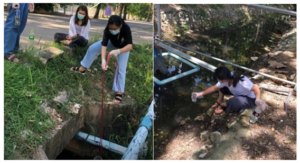
Figure 2: Water sample.
Study on the efficiency of household wastewater treatment
- Non-EM-enhancing activated carbon, EM-enhancing activated carbon, and EM microorganisms were added to the wastewater with a volume of 400 ml. Measurements were taken every 5, 10, and 15 minutes.
- At the end of the target date, remove the carbon from the sample water using a cheesecloth. Record the color and odors of the sample water to compare water quality before and after water treatment of EM-enhancing activated carbon, non-EM enhancing activated carbon, and EM microorganisms.
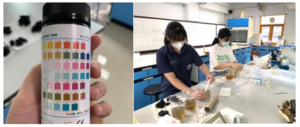
Figure 3: Various measurements and analyses the efficiency of wastewater treatment from households.
- Add duckweed into 110 ml. pre-treatment wastewater, as well as treated water following treatment using non-EM-enhancing activated carbon, EM-enhancing activated carbon, and EM microorganisms. Each type contains 10 plants. Observe the increase in the quantity of duckweed in water every 3 days for 9 days

Figure 4: Put aquatic plants in the wastewater.
Results and discussions
Observing Carbon's Physical Effects
Physical properties of each batch of carbon were examined under a stereomicroscope, specifically, the porosity of the carbon and the density of the carbon measured from the sinking point to the bottom of the container. As indicated in Tables 1 and 2, there was a change in the physical effect of carbon.
Type of plants
The number of pores in the carbon (hole/square centimeter)
After burning (Plants-base carbon)
After chemical activation with Calcium chloride (non-EM enhancing activated carbon)
After soaking with EM microorganisms (EM-enhancing activated carbon)
Corncobs
9
10
9
Tamarind woods
9
10
10
Durian husks
11
5
4
Coconut shells
7
9
9
Density of Carbon
Type of non-EM enhancing activated carbon n and EM-enhancing activated carbon
Durian husks
Tamarind woods
Corncobs
Coconut shells
The distance from the point where the carbon sinks to the bottom of the container (centimeter)
6.0
4.5
5.6
0.0
Chemical activation with calcium chloride improved the physical properties of the carbon, according to the results of the experiment in 3.1. The increased porosity of the carbon is the most obvious sign of this. Because calcium chloride activation is a chemical stimulant, it has an impact on the raw material changes within the carbon. The quality of the activated carbon will be improved when mixed with heat. This is in line with Teeradit Phothitantimongkhon's (2017) findings, which show that chemical activation results in activated carbon with high surface area and porosity.
Investigating the efficacy of carbon and EM microorganisms
When each set of activated carbons and EM microorganisms treated in household wastewater. The water was then measured with test kits and test strips. The color and odor of the water were observed every 5, 10, and 15 minutes and analyzed the efficiency of wastewater treatment. There were experimental results to check the efficiency of activated carbon and EM microorganisms as shown in Table 3 and Figure 5. (minutes) Unit cobs rind woods nut shells cobs rind woods nut shells
Time
Measurement Value
Trial kit
Control
non-EM enhancing activated carbon
EM
EM-enhancing activated carbon
Corn
Tama-
Durian husks
Coco-
Corn
Tama-
Durian husks
Coco-
5
TDS (ppm)
210
551
520
933
525
234
257
218
283
235
EC (μs/cm)
434
1050
1040
1880
1050
632
541
436
570
478
pH
7.2
7.2
7.2
7.2
7.2
6.2
7.2
7.2
7.2
7.2
Total alkalinity (mg/L)
80
80
80
120
120
0
120
120
120
120
Hardness (mg/L)
125
125
425
425
250
125
125
125
125
125
Color
+++
++
++
++
++
+++
+++
++
+++
++
Odors
+++
++
++
++
++
+++
+
+
+
+
10
TDS (ppm)
210
685
650
1725
710
359
272
230
355
256
EC (μs/cm)
434
1370
1258
3454
1378
710
544
460
712
512
pH
7.2
7.2
7.2
7.2
7.2
6.2
7.2
7.2
7.2
7.2
Total alkalinity (mg/L)
80
80
80
80
120
0
80
80
120
120
Hardness (mg/L)
125
250
250
250
250
250
125
250
125
250
Color
+++
+
+
+
+
++
++
+
++
+
Odors
+++
+
+
+
+
++
-
-
-
-
15
TDS (ppm)
210
747
715
1731
784
376
269
205
347
245
EC (μs/cm)
434
1494
1426
3734
1568
752
564
434
754
456
pH
7.2
7.2
7.2
7.2
7.2
6.2
7.2
7.2
7.2
7.2
Total alkalinity (mg/L)
80
80
120
80
120
0
120
120
120
120
Hardness (mg/L)
125
250
250
250
250
250
250
250
250
250
Color
+++
+
-
-
+
++
+
-
+
+
Odors
+++
-
-
-
-
+
-
-
-
-
Light green is the standard value - means colorless and odorless.
Dark green is a substandard value + means the intensity of color and odors.
Values other than those in the results table are unchanged and up to standard.
Table 3: The results of the experiment examined the efficacy of activated carbons and EM microorganisms.
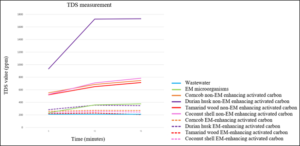
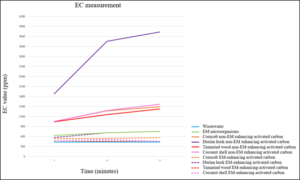
Figure 5: Comparison of efficacy testing of activated carbons and EM microorganisms.
The results of the experiment in 3.2, It was discovered that EM-enhancing activated carbon produced from tamarind wood has the ability to reduce TDS levels. Furthermore, EM-enhancing activated carbon produced from coconut shells could diminish the EC value. EM-enhancing activated carbon produced from tamarind and coconut shells was found to be effective in absorbing pollutants in wastewater. It's also more efficient than employing non-EM-enhancing activated carbon. During the 15th minute, the carbon will begin to absorb.
After soaking the carbon in water the good performance of coconut shell and tamarind wood carbon, which is a hardwood character, was linked to the number of pores in the carbon and a higher density than corncob and durian husk carbon. The lowest density of durian husk carbon indicates that this carbon is not suitable for wastewater treatment because the wastewater is less permeable to the carbon making it unable to treat thoroughly.
On the other hand, other carbons resulted in a gradual increase in TDS and EC values of water, indicating that there was a dissolution of the substance from carbon submerged in water, which affected the total solids content increase. As a result, considering they increase the number of contaminants in the water, these carbons should not be utilized in wastewater treatment. A component in the treatment of rotten odors in wastewater All carbons are equally good at treating wastewater odors. Moreover, the color of wastewater treated with EM-enhancing activated carbon tends to be dark from the color of EM microorganisms.
Testing with aquatic plants
From water testing with aquatic plants in each experiment set, duckweed was observed to increase the number of aquatic plants every 3 days for 9 days. There has been a change in aquatic plants. as in Table 4 and Figure 6. water (before) cobs rind woods cobs rind woods nut
Date
Examination/Observation
Duckweed
Waste
non-EM enhancing activated carbon
EM-enhancing activated carbon
EM
Corn
Tama-
Durian husks
Coco-nut shells
Corn
Tama-
Durian husks
Coco-
shells
Day 0 (start trial)
Number of duckweeds in the container (plants)
10
10
10
10
10
10
10
10
10
10
Day 3
Number of duckweeds in the container (plants)
15
15
16
15
16
18
13
18
16
17
Day 6
Number of duckweeds in the container (plants)
17
18
19
18
16
21
18
17
17
15
Day 9
Number of duckweeds in the container (plants)
29
30
30
30
20
28
21
27
25
Rot
Table 4: Water test results with duckweed.
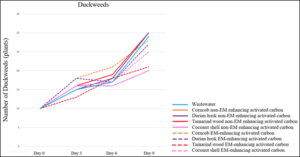
Figure 6. Compare the water test with duckweed.
In addition, the results of the use of water after treatment in all experimental sets for duckweed. It was shown that the wastewater treated with EM-enhancing activated carbon has a lower content of various substances affecting the nutrient content of aquatic plants due to the good adsorption efficiency of the wastewater. The EM-enhancing activated carbon resulted in a smaller increase in duckweed counts in the control unit and water treated with non-EM-enhancing activated carbon. Therefore, treating household wastewater with EM-enhancing activated carbon before discharging it into natural waterways in the community can help reduce the growth and propagation of aquatic plants.
Conclusion
- The physical properties of the carbon were improved after chemical activation with calcium chloride. The absorption of chemically activated carbon in calcium chloride with Effective Microorganisms did not influence the physical properties.
- In comparison to employing non-EM-enhancing activated carbon, EM-enhancing activated carbon manufactured from tamarind wood and coconut shell has higher adsorption effectiveness in wastewater. After 15 minutes of being soaked in water, the carbon began to absorb contaminant and odor. The coconut shell and tamarind wood carbon are better than corncob and durian husk carbon due to the greater density and the quantity of porosity in the carbon. Regarding the treatment of foul odors in wastewater, all carbons are equally effective in this regard.
- Treatment of household wastewater with EM-enhancing activated carbon before releasing it into community natural waterways can help reduce the growth and multiplication of aquatic weeds.
Acknowledgements
The study team would like to express our gratitude to the Enrichment program in Science, Mathematics, Technology, and the Environment (SMTE) of Uttaradit Daruni School for consistently supporting the project in all aspects. Thanks to the project advisors Ms. Sirilak Yamkong and Acting Lt. Wichayaporn Deebang for their guidance and understanding of the project. As well as Ms. Wariya Duangkaew, Uttaradit Daruni School's scientific operations officer, who helped and enabled the team to conduct this experiment. Thanks to all of the teachers and staff members of Uttaradit Daruni School who have contributed to and supported our effort. Finally, we would like to express gratitude to our families for their unwavering support and encouragement throughout the project.
References
- Chaweewan Pengpitak (2019). Activated Carbon Adsorbed Chemicals and Consumer Products Division, Department of Science Service.
- Electricity Generating Authority of Thailand (EGAT) (2016). Efficiency microorganisms (EM).
- Paweena Paweena Limpiteeprakarn (2019). The efficiency of EM Ball from organic waste in wastewater treatment in Ubon Ratchathani Province.
- Pornpornsathit (2018). Investing in charcoal production from corncobs.
- Rujira Rujira Pinkaew (2013). Production and preparation of activated carbon from corncobs for methane absorption.
- Sukontip, Towmola (2018). Preparation, analysis, and application of activated carbon from agricultural waste materials from eastern Thailand as a heavy metal adsorbent from an aqueous solution. Burapha University.
- Teeradit Photantimongkol (2017). Activated Carbon from Agricultural Waste Materials by Chemical Stimulation for Water Pollution Removal Applications, Department of Chemistry.